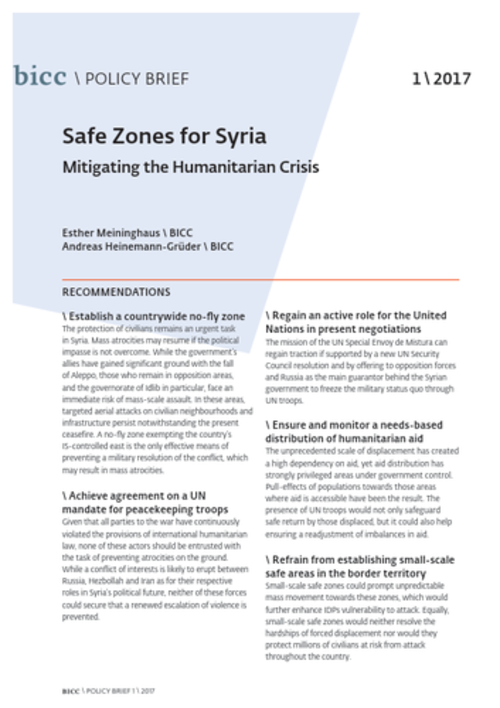Publications
Safe zones for Syria: Mitigating the humanitarian crisis
Release Date
2017-02
Language
- English
Topics
- –
The upcoming Syria negotiations in Geneva on 20 February 2017 may prove fundamental in deciding on the future of the country. In their Policy Brief “Safe zones for Syria. Mitigating the Humanitarian Crisis”, BICC researchers Esther Meininghaus and Andreas Heinemann-Grüder discuss the question whether no-fly zones and UN ground forces could be a possible scenario. The authors also focus on aid imbalances and further protection needs.
In BICC Policy Brief 1 \ 2017 “Safe zones for Syria. Mitigating the Humanitarian Crisis” the authors in particular recommend:
\ Establish a countrywide no-fly zone
The protection of civilians remains an urgent task in Syria. Mass atrocities may resume if the political impasse is not overcome. While the government’s allies have gained significant ground with the fall of Aleppo, those who remain in opposition areas, and the governorate of Idlib in particular, face an immediate risk of mass-scale assault. In these areas, targeted aerial attacks on civilian neighbourhoods and infrastructure persist notwithstanding the present ceasefire. A no-fly zone exempting the country’s IS-controlled east is the only effective means of preventing a military resolution of the conflict which may result in mass atrocities.
\ Achieve agreement on a UN mandate for peacekeeping troops
Given that all parties to the war have continuously violated the provisions of international humanitarian law, none of these actors should be entrusted with the task of preventing atrocities on the ground. While a conflict of interests is likely to erupt between Russia, Hezbollah and Iran as for their respective roles in Syria’s political future, neither of these forces could secure that a renewed escalation of violence is prevented.
\ Regain an active role for the UN in present negotiations
The mission of the UN Special Envoy de Mistura can regain traction if supported by a new UN Security Council resolution and by offering to opposition forces and Russia as the main guarantor behind the Syrian government to freeze the military status quo through UN troops.
\ Ensure and monitor a needs-based distribution of humanitarian aid
The unprecedented scale of displacement has created a high dependency on aid, yet aid distribution has strongly privileged areas under government control. Pull-effects of populations towards those areas where aid is accessible have been the result. The presence of UN troops would not only safeguard safe return by those displaced, but it could also help ensuring a readjustment of imbalances in aid.
\ Refrain from establishing small-scale safe areas in border territory
Small-scale safe zones could prompt unpredictable mass movement towards these zones, which would further enhance IDPs vulnerability to attack. Equally, small-scale safe zones would neither resolve the hardships of forced displacement nor would they protect millions of civilians at risk from attack throughout the country.
PDF-Download
BICC_Policy_Brief_2017_1_01.pdf
[English] (187.42 KB)

Cite as
@techreport{MeininghausHeinemann-Gruder2017,
author = "Esther Meininghaus and Andreas Heinemann-Grüder",
title = "Safe zones for Syria: Mitigating the humanitarian crisis",
latexTitle = "Safe zones for Syria: Mitigating the humanitarian crisis",
publisher = "BICC",
number = "1",
institution = "BICC",
type = "BICC Policy brief",
year = "2017",
address = "Bonn",
}
Document-Type
BICC Policy brief
Publisher
BICC
Place
Bonn
Countries/Region
Syria



